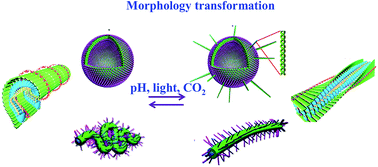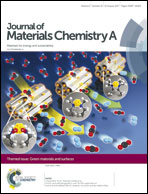Morphology transformation of self-assembled organic nanomaterials in aqueous solution induced by stimuli-triggered chemical structure changes
Abstract
Stimuli-responsive shape transformation plays an important role in organisms at various scales, from the molecular, cellular, and to the macroscopic range, and through this process biological entities maintain their normal functions or respond to stress. In recent years, stimuli-triggered self-assembly has been developed to provide elaborate control over structural transformation in supramolecular entities. Various kinds of stimuli-responsiveness have been achieved by incorporating stimuli-sensitive groups into the building blocks in the supramolecular systems, such as pH, light, temperature, redox, and CO2 responsiveness. Therein, facilely available and tractable pH, light, CO2, and enzyme triggers have attracted increasing attention. They usually cause changes in the chemical structure of the corresponding responsive groups in the self-assembly building block molecules, leading to large and robust alternations in hydrophobicity/hydrophilicity, polarity, and charge. Therefore, the morphology and property transformations of self-assembled nanostructures can be modulated effectively and efficiently. The stimuli-triggered morphology transformation of supramolecular assemblies provides a powerful approach to prepare functional organic nanomaterials with well-defined structures in water. Through this approach, nanomaterials with complex and unique morphologies (e.g., micro-/nanostructures or a hierarchical sac structure) can be obtained, which are otherwise inaccessible via conventional self-assembly processes. The dynamic nature of these in situ supramolecular transformations enables applications in photo-electrical devices, sensing, hierarchical cargo release, and in the construction of metastable materials, etc. Avoidance of the use of organic solvents, a simplified in situ fabrication process, and operation in combination with relatively “green” triggers, such as pH, light, CO2, and enzymes, promote this approach as an environmentally friendly and economic strategy for the development of “green materials”. Herein, we review the morphology transformations of self-assembled organic nanomaterials in aqueous solution induced by pH, light, CO2, or enzyme-triggered chemical structure changes. This review mainly focuses on the design, transformation conditions, morphology changes, mechanisms, and possible functions of the supramolecular transformation systems.

- This article is part of the themed collections: Recent Review Articles and Green Materials and Surfaces


 Please wait while we load your content...
Please wait while we load your content...